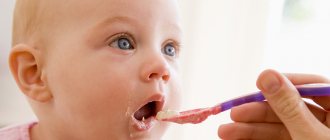Baby's temperature: which feeding mode to choose?
If your baby gets sick with ARVI, consult a doctor as soon as possible! In such little ones, all diseases develop very quickly and are often severe. Until the doctor arrives, a small child with a fever can continue to be breastfed if he does not refuse it. Mother's milk for a baby is nutrition, drink and medicine at the same time. Put your baby to your breast, especially if he is naughty. This will help him calm down and cope with the disease faster. Give your baby some warm boiled water from a spoon or bottle. The correct drinking regime is especially important for “artificially-trained” people; for them, colds are dangerous due to dehydration.
Air in the room: cool, humid, fresh
It is necessary that the air temperature in the sick child’s room is no higher than normal (20–21 °C), and the air is humidified.
Some doctors even recommend a moderately reduced air temperature - 16–18 °C, and there is a reason for this. The fact is that heat transfer from the surface of the child’s body is difficult if the room is very warm and the child is thoroughly wrapped up. The child also gives off heat when breathing, inhaling cool air and exhaling air that has warmed up in the lungs to body temperature. Moreover, the greater the temperature difference, the greater the heat transfer, the less likely it is that the child’s body temperature will rise to very high numbers.
Humid air is necessary, firstly, to maintain moisture in the mucous membranes of the respiratory tract, otherwise the child will not be able to cough up thick and viscous sputum. Secondly, to combat the increase in body temperature, the child has to sweat. If he is in a room with low humidity, the inhaled dry air in the lungs is humidified to 90–100% (think of the steam from the mouth when breathing in cool weather). With each exhalation, the child loses fluid, and the breathing rate in small children is 2-3 times faster than in an adult. During the day, a child loses up to half a liter of fluid through breathing. What kind of sweating is there...
If you live in a house with central heating, it is advisable to either use a special humidifier or hang a damp terry towel on the heating radiator several times a day. This will make the child's breathing easier and promote effective coughing.
The air in the room where the sick child is located must be fresh . To do this, the room must be ventilated several times a day. The following is considered the optimal method of ventilation. The child is taken to another room for a while, the vents (windows) and the door are simultaneously opened in the room for a few minutes, creating a draft. At the same time, the walls and furniture do not have time to cool down, and after ventilation, the air temperature in the room is very quickly restored. Ventilation allows you to remove microorganisms that have accumulated there from the room. Wet cleaning of the room also contributes to this.
How to feed at high temperatures?
If a child is sick, you should never force-feed him! Do not persuade your child to eat, but regularly offer different light, beautiful, “interesting” dishes:
- vegetable and fruit purees, mousses,
- jelly,
- porridge,
- soft sweet fruits,
- curds and yoghurts with jam or honey,
- kefir and milk - low-fat, without cream,
- cracker.
All food should be at room temperature or slightly warmed so as not to irritate the throat.
In children, high fever is often accompanied by vomiting. After it, you cannot feed the baby for 1-2 hours, even if he asks. Give him a warm drink more often - 1 spoon every 15-20 minutes. If the liquid does not cause a new attack of vomiting, try feeding, for starters - something light and liquid.
Some children maintain a healthy appetite even with a high fever. During illness, it is better to reconsider your diet. Give your baby light meals in small portions, every 1-2 hours, so as not to overload the stomach. If he does not eat enough during the main feeding, offer juice, kefir, fruit purees or jelly.
The first days after recovery, the baby may continue to refuse regular, familiar food. Don’t panic: a child’s body needs time to recover from an illness, not only physically, but also emotionally. Delight your child with “tasty food” and return to the usual diet gradually:
- Start adding steamed meat or fish and boiled vegetables to your menu.
- Offer your child a normal-sized portion, but do not insist that he finishes everything.
If your baby refuses to eat even a week after illness, consult your pediatrician. The doctor will help restore your feeding regimen.
Cottage cheese in a child’s diet: why and how much to give.
12.05.2020 5599 0
If your baby is 4 months or older, your pediatrician and your mother have already talked to you about complementary feeding. If their advice is very different, you may be having a hard time deciding what food to give your baby and when.
WHO and the Union of Pediatricians of Russia offer similar timing for the introduction of complementary foods and products*, **. But 30 years ago the rules were different, so grandma may insist on something different.
This contradiction also applies to cottage cheese. Here, in addition to the conflict of traditions and the position of medical experts, statements like: “Products made from cow’s milk often cause allergies!” can be even more confusing!
Does your baby need cottage cheese?
Yes I need it. Cottage cheese is a healthy food: it contains protein, calcium, phosphorus and vitamins*, ***. But the child’s intestines must be ready to absorb it.
How much cottage cheese can a child have?
A little. Pediatric experts suggest introducing your baby to cottage cheese when he is 8-9 months old. Cottage cheese is introduced after fermented milk drinks: kefir, yogurt.
Or you can first introduce cottage cheese at 8 months, and after 2-3 weeks, fermented milk drinks. The first time it is enough to give one “pea” on the tip of a spoon*.
In the table below you can see the amount of cottage cheese in grams for children under one year old. The figures are taken from the website of the Union of Pediatricians of Russia**.
| 8 months | 9-12 months |
| 0 g → 40 g | 40 g → 50 g |
WHO does not say exactly how much cottage cheese a child under one year old can eat. Their manual notes that fermented milk products, in principle, should be given to the baby for its proper development.
So you will benefit your baby if you start giving him cottage cheese from 8-9 months.
What about an allergy to cow's milk protein (CMP)? It happens rarely. It occurs in 2-3% of infants according to the Union of Pediatricians of Russia****.
You may suspect an allergy to CMP in a child if:
- You are breastfeeding and the milk from your table is affecting his tummy
- After a fermented milk dish, the baby develops unpleasant symptoms: regurgitation, vomiting, constipation, colic, blood in the stool or shortness of breath. If you have shortness of breath, you should call an ambulance immediately. True, this happens very, very rarely. I've only seen this once in my life
- Your baby stubbornly refuses to eat dairy products
- The skin around the mouth itches and swells immediately after eating this food
- The child eats milk well, but really gains little weight and often suffers from diarrhea****
If the allergy is not very severe, it is difficult to diagnose.
To determine what's causing your tummy or skin problems, ask your pediatrician for help. He will explain how the effect of different products on a child is monitored. You won't miss an allergy to CMP if you monitor your baby's reaction to milk and work together with a pediatrician you trust.
What kind of cottage cheese should I give my child?
Children's. Usually a mother chooses from two options: buy it in a store or find recipes for children and cook it herself.
If you decide to feed your baby ready-made cottage cheese, then:
- Buy cottage cheese labeled “for feeding young children” ***. There are more stringent requirements for such a product compared to “adult” ones.
- Choose cottage cheese without sugar
If your baby starts eating sweets early, he will get used to them. Then it will be difficult to instill in him the habit of eating healthy food. Sugar in the mouth is the main cause of tooth decay*.
If you are going to make the cottage cheese yourself, then:
- Buy the right milk. The best option is high-quality milk according to GOST. Cow's milk "from familiar grandmothers" may contain dangerous microbes, for example, E. coli. If it gets into food, it will cause poisoning
- Use thoroughly washed dishes and clean gauze for squeezing.
- Follow the recipe for children. Cottage cheese is prepared not only from milk, but also from baby kefir. Cottage cheese recipes for children are available on the Internet, for example, on the Russian Medical Server forum *****.
What to do if your child doesn’t want to eat cottage cheese “as much as the doctor said”?
Correct the situation with love and patience. There are 2 possible problems here:
- doesn't eat at all
- that's all he eats.
He doesn’t eat cottage cheese at all – and at the same time there is no allergy to CMB. Then your ingenuity will help you feed your stubborn baby healthy food.
Below are five solutions:
- Add cottage cheese to another complementary food: puree or kefir. Create your own cottage cheese recipes for children
- Dilute the cottage cheese with unsweetened yogurt and offer to dip pieces of food in it if your baby can already eat them
- Offer another brand of cottage cheese for babies
- Serve cottage cheese in an interesting way: make a ball, make a face out of it using pieces of fruit or vegetables
- If the baby turns away from cottage cheese, but enjoys drinking kefir or yogurt, let them remain in the diet.
If you treat this difficulty as an interesting task, you will probably come up with other options.
He only eats cottage cheese. The main thing is to give cottage cheese without sugar. Offer other food to a hungry baby, and allow him to eat it himself. It happens that they offer more than once or twice. Imagine teaching a little alien to eat Earth food. Sometimes learning takes a long time.
If that doesn't work, get your baby interested in mommy's plate. Place the non-curd food on the edge of your plate during meals. Place your baby on your lap and let him steal some from your plate and taste it. Gradually you will find how and how to distract your baby from the desire to eat only cottage cheese. The main thing here is to calmly tell yourself that this too will pass.
What's the result? You can handle it.
- Cottage cheese is healthy.
- It is given from 8 months, starting with a “pea”. The norm for 1 year is 50 g.
- You can influence what and how much your child eats without pushing.
- Many problems go away with age and affectionate treatment.
Links for more details:
* Kim Fleischer Michaelsen, Lawrence Weaver, Francesco Branca and Aileen Robertson, Feeding and Nutrition of Infants and Young Children. — WHO regional publication, European series, No. 87, 2003, Updated reprint, xix + 369 pp. ISBN 92 890 4340 7. ** Website of the Union of Pediatricians of Russia *** GOST 32927-2014 Cottage cheese for baby food. **** Allergy to cow's milk proteins in children. Clinical recommendations of the Union of Pediatricians of Russia, 2021 ***** https://forums.rusmedserv.com/
(1 ratings; article rating 5.0)
Share Share Share
What should you not feed if you have a cold?
When you have a fever, do not overload your stomach. During illness, exclude from the child’s diet:
- fatty dairy products,
- yeast dough, baked goods,
- red meat,
- fatty fish,
- chocolate,
- new, previously untried dishes and flavor combinations,
- pickled vegetables,
- products containing vinegar.
Avoid foods with strong tastes, spices, sour and salty foods. They irritate the stomach and can increase inflammation in the throat.
Modern doctors do not recommend feeding children meat broths: when cooked, all the harmful substances from meat get into them. Offer your baby a light vegetable or milk soup. When the temperature drops, you can feed your baby tender chicken soup with a second broth.
Possible causes of high temperature in a child
The first place among the causes of fever is acute respiratory infections2, which children and adolescents under 17 years of age suffer from 3-5 times more often than adults7. In 5-10% of cases, fever is associated with sinusitis, pneumonia, meningitis, urinary tract and bone infections2.
But infection is not the only cause of high fever. Among non-infectious causes there are 9:
- central - various brain injuries, for example, trauma, edema;
- immune - allergies, some autoimmune diseases, for example, vasculitis (damage to the walls of blood vessels);
- psychogenic - emotional stress and neuroses;
- reflex - severe pain during an attack of renal or biliary colic;
- endocrine - hyperthyroidism (increased levels of thyroid hormones);
- hereditary - Mediterranean fever (periodic disease);
- medicinal - taking certain medications.
If the thermometer shows a rise in temperature by 1–1.5 degrees, do not rush to panic3. Perhaps the child is simply overheated3.
Overheating often occurs after exercise, a hot bath, walking in hot weather, and even after eating2,3,4,10. Before re- measuring , make sure that the room is not too warm - the microclimate can also affect the thermoregulation of the child’s body3. Remember also that during the day the temperature fluctuates between 0.5 - 1 0C, reaching a maximum in the evening1.
Is immunity really developed?
There is no consensus on this matter.
It is believed that high temperature is the body’s response to the penetration of viruses, microbes, and bacteria into it. And the pyretic mechanism, which turns on at this moment, helps to literally “fry” all these harmful strangers. When are antipyretic medications needed? Many pediatricians advise parents to do the following - if the baby has a fever, and he tolerates it quite well, continues to do his work, plays and does not experience weakness - then antipyretics should not be given up to the maximum limit of 38.5 degrees.
If the baby is literally lying flat, and in previous cases of hyperthermia he had convulsions or vomiting, then the medicine must be given, and not wait for the number 38.5 on the thermometer.











